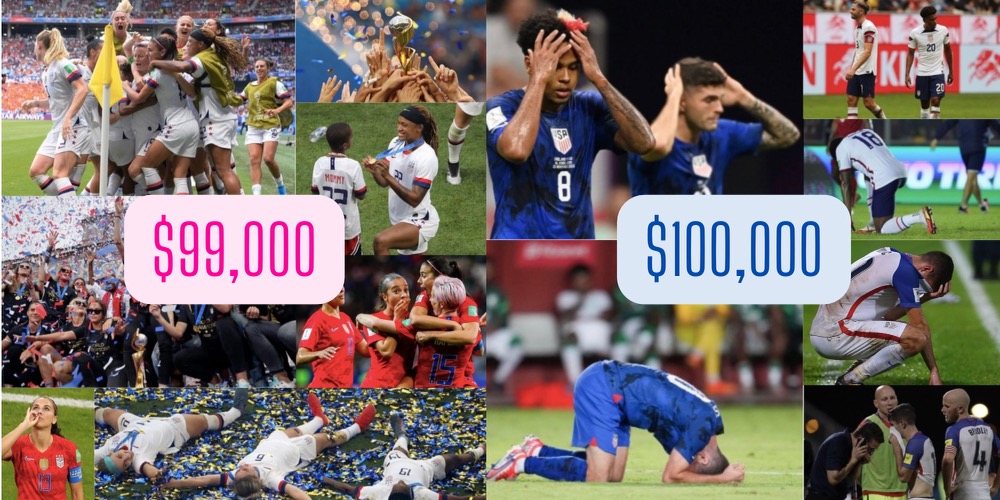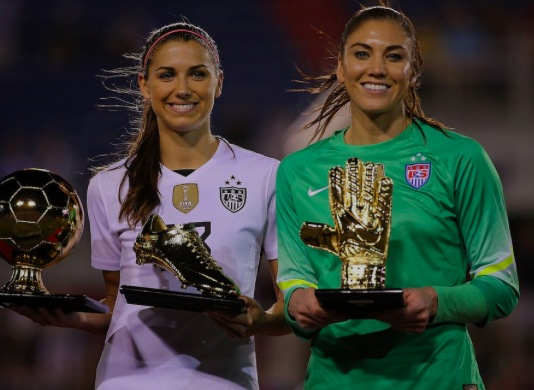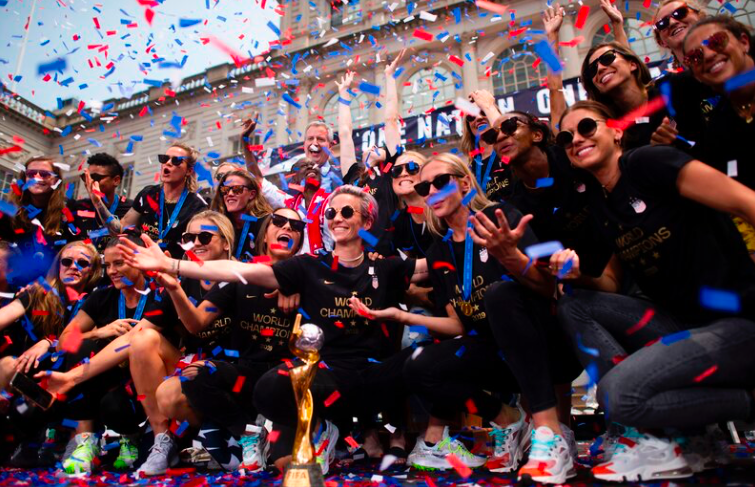Have you ever been told that you throw like a girl? Or that you run like a girl? Typically, the phrase “like a girl” has a negative connotation of being weak. Female athletes receive significantly less praise, recognition, respect, and especially pay than male athletes, as shown through the massive wage gap between the United States men and women’s national soccer teams up until 2022.

American female professional soccer players were each paid $3,600 per exhibition game in 2015. If the women’s team played 20 games in a year and won all of them, they would make $99,000 in bonuses. If they lost all their games, they would make $72,000. Male players’ salaries are drastically different; they were paid $5,000 per exhibition game. If they won all their games, they would make $263,320, and if they lost all their games, they would make $100,000 (McCarthy 2016). This wage gap categorizes female players as less worthy and inferior to their male counterparts despite playing the same game.
Suing for women’s pay equality
In an effort to address long standing wage inequality in professional soccer, United States women’s national team players Alex Morgan, Meghan Rapinoe, Becky Sauerbrunn, Hope Solo, and Carli Lloyd filed an initial complaint of unequal pay in 2016.

After nothing came from this complaint, 28 members of the USWNT filed a lawsuit in 2019 “citing years of ongoing institutionalized gender discrimination against their compensation and working conditions” (Lenthang 2022).

During the lawsuit, the USWNT claimed that the The United States Soccer Federation (USSF) created separate compensation structures for the gendered teams, regardless of each team’s performance and revenue, women were to be paid less. In response to this claim, the USSF argued that “market realities [were] such that the women [did] not deserve to be paid equally to the men” (Felcher 2020). Relying on these ‘market realities,’ like ticket sales, selling merchandise, number of television viewers, is a false pillar to rely on, as “from 2016-2018, women’s games generated approximately $50.8 million in revenue, compared with $49.9 million for men’s game” (Johnsen Hess 2019). The women’s team have shown that they can match if not exceed the men’s team’s revenue, showing that no market realities are holding them back. The USSF’s defense revealed the ideology of female inferiority that they relied on in explaining their mistreatment of the USWNT.
This case got national attention due to the women’s national team’s tremendous success compared to the US men’s team. The women’s team has won four FIFA World Cup titles since its creation in 1991, whereas the closest the men’s team has been to a FIFA World Cup was when they took third in the first World Cup in 1930. Additionally, in 2018 FIFA men’s World Cup the winning team was awarded $38 million in prize money. By contrast, in the 2019 FIFA women’s World Cup, the USA won their second consecutive FIFA title and was only collectively awarded $4 million (Lenthang 2022).

The lawsuit was finally settled in 2022 granting the USWNT team an equal salary to that of their male counterparts (Lenthang 2022). After 37 years of unequal pay, the women’s soccer team won fair pay by uniting with each other and collectively taking their case to court, fighting the societal issue of the wage gap to solve their personal trouble of being paid less than men in their sport.
Celebrating equal pay
Women in sports smash typical female stereotypes depicting women as weak, helpless, and inferior. Yet, their pay failed to reflect their status, and instead affirmed that they were inferior to men. This pay discrepancy reflects a larger pattern in the U.S. and around the world. In America, women make 82 cents for every dollar that a man makes (Jones 2021). The USWNT’s fight for equal pay is a step in the right direction. Society has shifted, and as it shifts, one can only hope the wage gap grows closer and closer until one day disappearing, like it has for the US women’s national soccer team.
References:
Blau, Francine D., and Lawrence M. Kahn. 2017. “The Gender Wage Gap: Extent, Trends, and Explanations.” Journal of Economic Literature 55(3):789-865. https://ez.hamilton.edu/login? url=https://www.jstor.org/stable/26303306
Felcher, Melissa C. 2020. “An Uneven Playing Field: Remedying the Professional Sports Wage Gap by Revising the Equal Pay Act.” Brooklyn Law Review 86(2):627-659. https://heinonline.org/HOL/Pagelname=&public=false&collection=journals&handle=hein.journals/brklr86&men_hide=false&men_tab=toc&kind=&page=627
Lenthang, Marlene. 2022. “U.S Soccer and women soccer stars settle equal pay lawsuit for $24 million.” NBC News Digital. Retrieved October 10, 2022. https://www.nbcnews.com/news/us-news/us-soccer-women-soccer-stars-settle-equal-pay-lawsuit-24-million-rcna17138
McCarthy, Niall. 2016. “The U.S. National Soccer Team’s Gender Pay Gap” Statista. Retrieved September 28, 2022. https://www.statista.com/chart/4573/the-us-national-soccer-teams-gender-pay-gap/
Jones, Janelle. 2021. “5 Facts About the State of the Gender Pay Gap.” US Department of Labor Blog. Retrieved October 10, 2022. https://blog.dol.gov/2021/03/19/5-facts-about-the-state-of-the-gender-pay-gap
Rho, Deborah. 2021. “What Causes the Wage Gap?” University of Minnesota. Retrieved October 10, 2022. https://genderpolicyreport.umn.edu/what-causes-the-wage-gap/
Johnson Hess, Abigail. 2019. “US women’s soccer games now generate more revenue than men’s–but the players still earn less.” CNBC. Retrieved November 3, 2022. https://www.cnbc.com/2019/06/19/us-womens-soccer-games-now-generate-more-revenue-than-mens.html